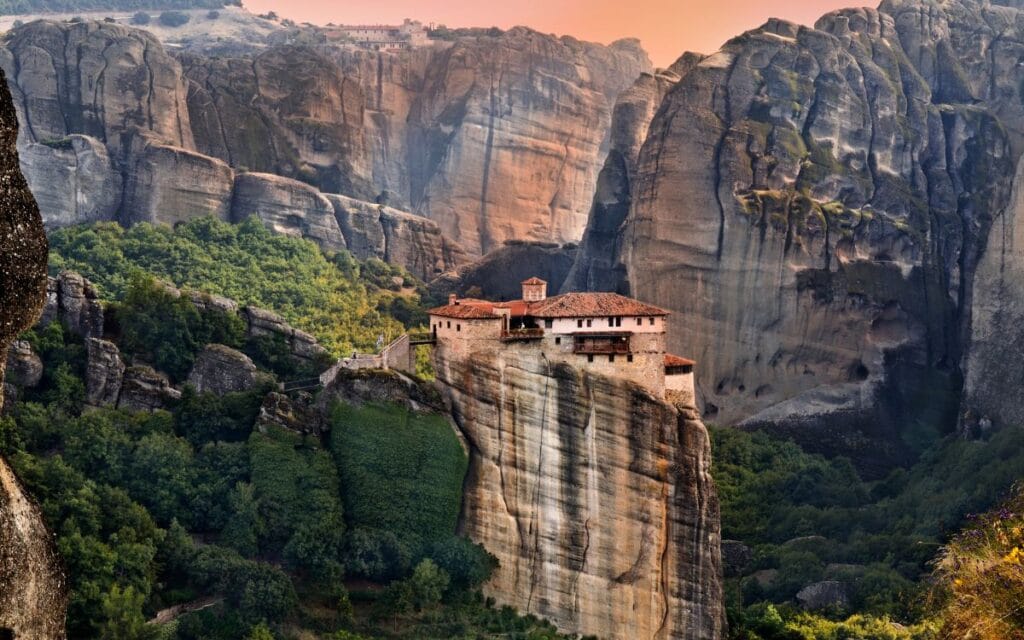Meteora Greece
Meteora Greece

The most striking feature of Meteora is its dramatic rock formations. These towering sandstone pillars, some of which rise to nearly 400 meters (1,300 feet) high, create a surreal and otherworldly landscape that has fascinated travelers for centuries. The geological history of Meteora dates back millions of years, formed through a combination of erosion and natural forces that shaped these towering cliffs. The landscape is not only a marvel of nature but also offers a variety of hiking and climbing opportunities, allowing visitors to explore the area’s unique terrain from different perspectives.
What makes Meteora even more remarkable is its historic monasteries, which were built on top of these rocky peaks. In the 14th century, monks sought refuge in these remote and difficult-to-access locations, building monasteries that became centers of religious and spiritual life. At one point, Meteora was home to 24 monasteries, but today, only six remain active. These monasteries are among the most significant religious landmarks in Greece and offer visitors a glimpse into the rich spiritual heritage of the region.
The six monasteries of Meteora are: The Great Meteoron Monastery, Varlaam Monastery, Rousanou Monastery, St. Nicholas Anapausas Monastery, St. Stephen’s Monastery, and the Holy Trinity Monastery. Each of these monasteries is unique in its own right, offering stunning views, beautiful frescoes, and centuries-old artifacts. The Great Meteoron Monastery is the largest and most famous, with its impressive architecture and rich history. The monastery complex includes a church, a library, and a museum, and it provides an incredible insight into the lives of the monks who once lived there.
Varlaam Monastery is another must-see, known for its striking beauty and historical importance. Visitors can also explore the Rousanou Monastery, which is smaller but equally captivating. The St. Stephen’s and Holy Trinity Monasteries are accessible by bridges and offer some of the most picturesque views of the surrounding landscape. Each monastery offers a peaceful atmosphere, perfect for reflection, while also providing a glimpse into the region’s religious traditions, artwork, and history.
Aside from the monasteries, Meteora also offers incredible natural beauty and a range of outdoor activities. Visitors can hike along the marked trails that wind through the rock formations, taking in panoramic views of the landscape. These trails vary in difficulty, catering to both beginners and experienced hikers. The views of the surrounding valley and the town of Kalambaka below are simply breathtaking. For those seeking an adrenaline rush, climbing the towering rock formations is a popular activity, though it requires the proper equipment and expertise.
The town of Kalambaka itself is a charming destination at the foot of the Meteora rocks. It is the perfect base for exploring the area, with many hotels, restaurants, and cafes offering stunning views of the surrounding landscape. The town also has a variety of shops selling local products, such as handcrafts, herbs, and cheeses, making it an ideal place to pick up souvenirs.
For those interested in the history and culture of Meteora, the Meteora Museum of Natural History and the Archaeological Museum of Kalambaka offer fascinating exhibits on the geology, flora, and fauna of the area, as well as the history of the monasteries and the lives of the monks.
In conclusion, Meteora is a place where natural beauty, history, and spirituality come together in a truly unique way. Whether you’re exploring the ancient monasteries, hiking through the breathtaking rock formations, or simply soaking in the serenity of the landscape, Meteora offers an unforgettable experience for every visitor. Its combination of historical, cultural, and natural significance makes it one of Greece’s most remarkable destinations and a must-see for anyone visiting the country.

